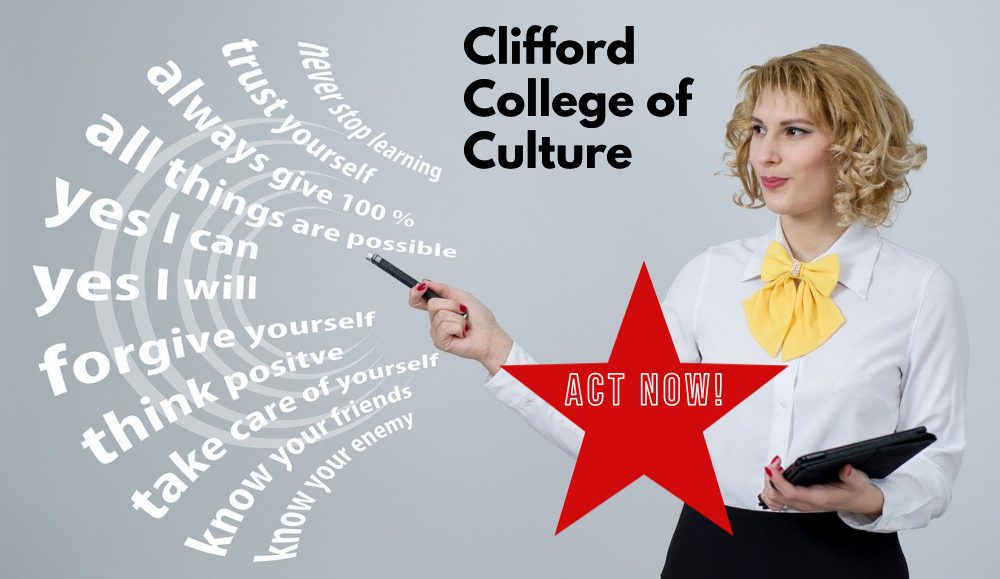
At an art museum, are your comments limited to “I like that one”? After an opera, is your most perceptive remark “The singers were good”? Would you like to appear more cultured and sophisticated? Impress others with your penetrating observations and discerning interpretations?
Now is your chance! For a limited time only, The Clifford College of Culture (no affiliation with Trump University) is offering our world-renowned seven-step connoisseurship program for the unbelievably low price of $98.95, or four easy payments of $39.95.
In only four hours you can learn to talk like an art expert. And you need not learn anything about the arts. You will be considered a cognoscente of painting, classical music, opera, literature, poetry and theatre, while remaining ignorant of these subjects. But you must act now. We have only a few openings left.
In a single afternoon you will master the seven sure fire ways of displaying your cultural savoir-faire:
- Disavow expertise while implying vast knowledge. For example, “I regret that they I didn’t spend more time studying French symbolist poets.” This creates the false implication that you did study other schools of poetry.
- Avoid both approval and disapproval of artworks. Instead, note the blindingly obvious. For example, when viewing a landscape painting, observe anything in the middle ground. “Note Constable’s discreet placement of trees in the middle ground.” You can say with confidence, BECAUSE YOU CANNOT BE WRONG. No one can contradict you and claim there are no trees in the middle ground. In a portrait, comment on the presence or absence of the subject’s left hand.
- Hint that that what you just noticed reveals the artist’s recondite intentions. “I find the absence of the left hand revealing.” You may also find the obvious to be telling, instructive, illuminating or enlightening. AGAIN, YOU CANNOT BE WRONG.
- Discern nuances. Finding nuances is the unequivocal signal of an American intellectual, especially if you detect them where they don’t exist–nuanced colors in a monochromatic painting, nuanced fluidity in twelve-tone music, or nuanced meter in a short story.
- Use oxymorons. They stamp you as broad minded and holistic. If you find a work of art to be manifestly covert, deceptively honest, or ominously auspicious, everyone will nod in agreement. No one will dare to say, “That makes no sense. What the hell are you talking about?”
- End with a question to which there is no good answer, for example, “Will audiences still consider this a great symphony in 2201?”
- Do not say another word. Remember the salesman’s adage: After you have made the sale, shut up
Here are how the seven steps work at the intermission after the first act of Waiting for Godot:
First speaker: Do you like it?
Second Speaker: I think it’s very well acted.
You, now a connoisseur graduate of The Clifford College of Culture, can speak with authority:
- Disavow knowledge: “I wish I had seen more of Beckett’s plays when I was in Dublin.” You can say this even if you spent only two days in Dublin and never came near a theatre.
- State the obvious: “Each of the four principal characters has no last name.” YOU CANNOT BE WRONG.
- Hint at artistic intention: “It is instructive that the names of the lead characters, Vladimir and Estragon, are three syllables, while secondary characters Pozzo and Lucky both two syllables. Becket did not choose these lengths randomly.”
- Discern nuances: “The staging underscores the nuanced collision of the comic with the tragic.”
- Use oxymorons: “Beckett’s characters live in a world of irrational sanity laced with sane irrationality”
- Ask a question that cannot be answered: “Does the immediacy of this production eclipse abstruse, but more pivotal, questions?”
- Do not say another word.
But wait, there is more. If you call right away, we will add a free one-hour session on the six magic art words. Each magic word is applied to a different art. Once we teach you the definitions of these six words, you simply comment on the relative presence or absence of this feature in the work of art, for example, perceiving overstated rubato in a symphonic performance.
The magic words are:
Painting: Chiaroscuro.
Classical Music: Rubato.
Opera: Portamento.
Literature: Synecdoche.
Poetry: Enjambment.
Theatre: Theatricality.
This offer comes with a money back guarantee and is not available in stores. Act now. Operators are standing by.
Discover more from Post Alley
Subscribe to get the latest posts sent to your email.

Best money I ever spent. Cheap wine in plastic cups now tastes like social triumph.
Perfect!!! Works every time